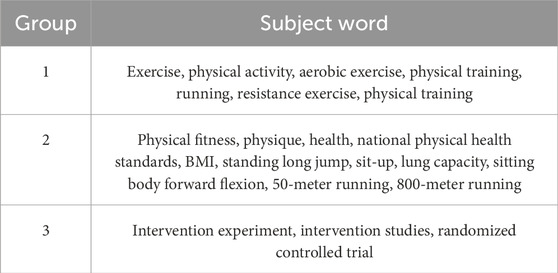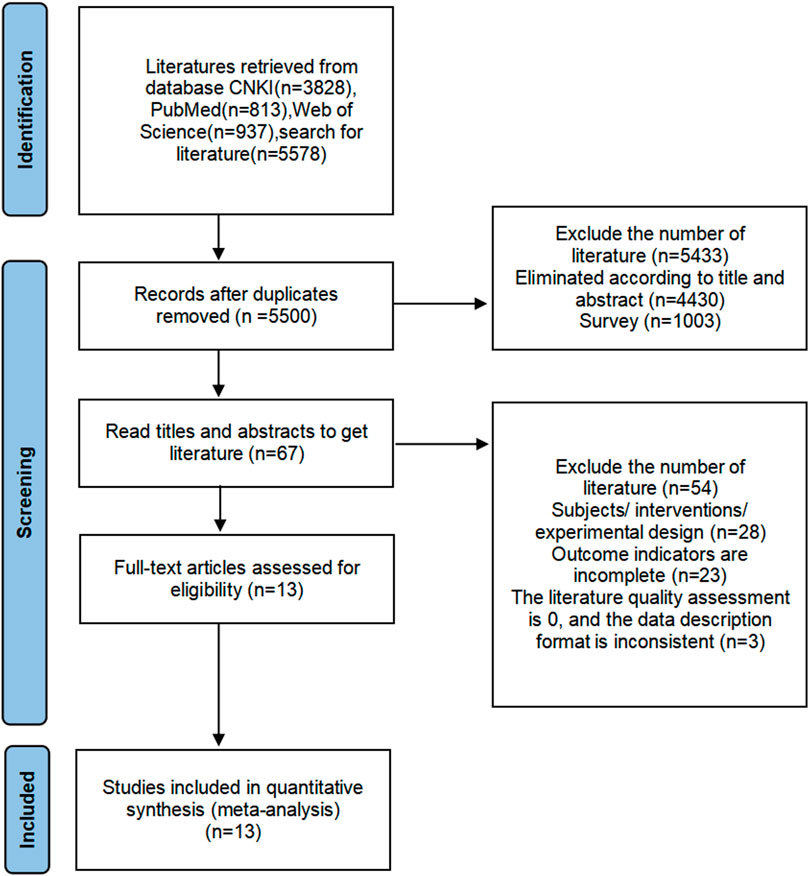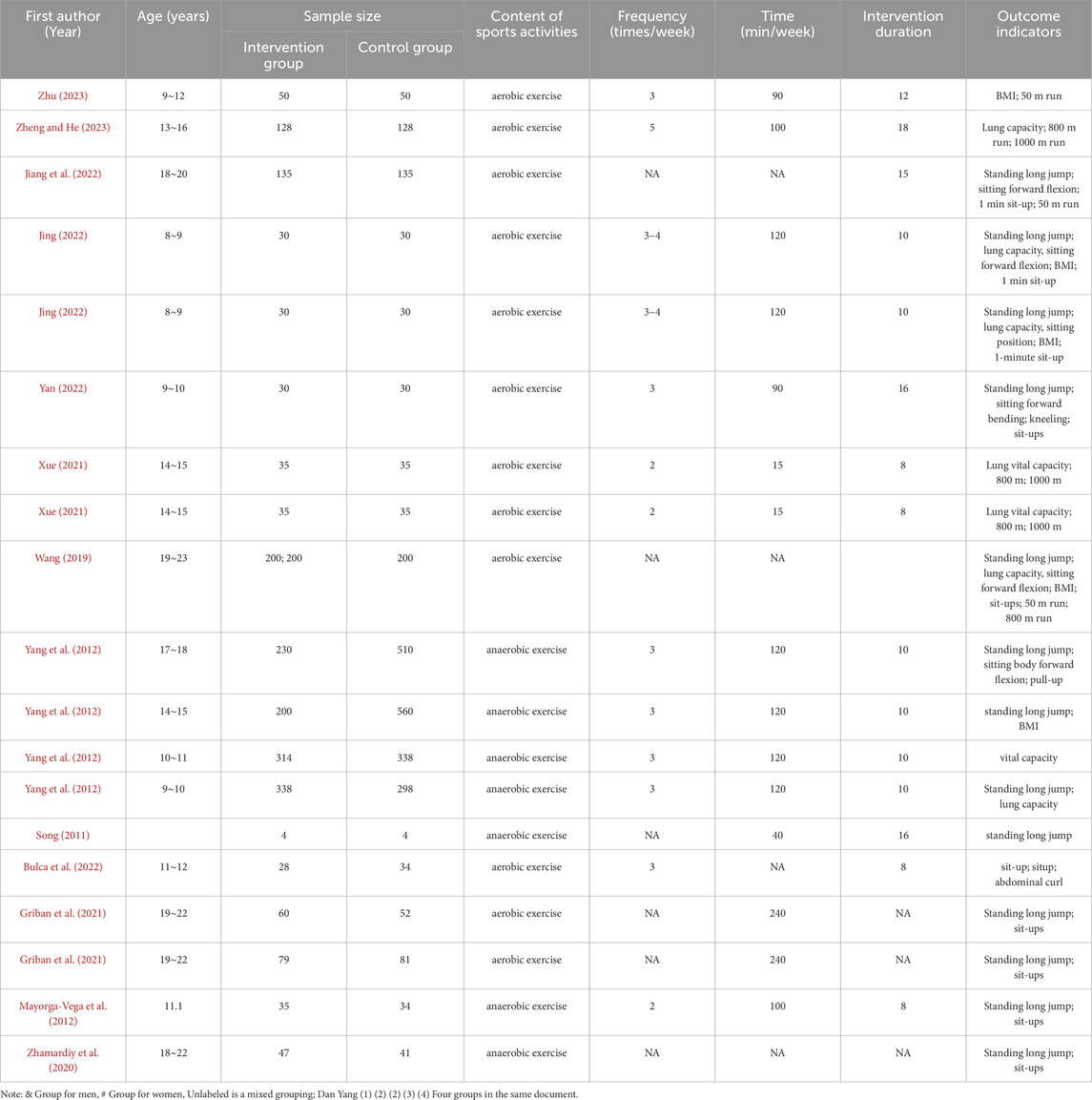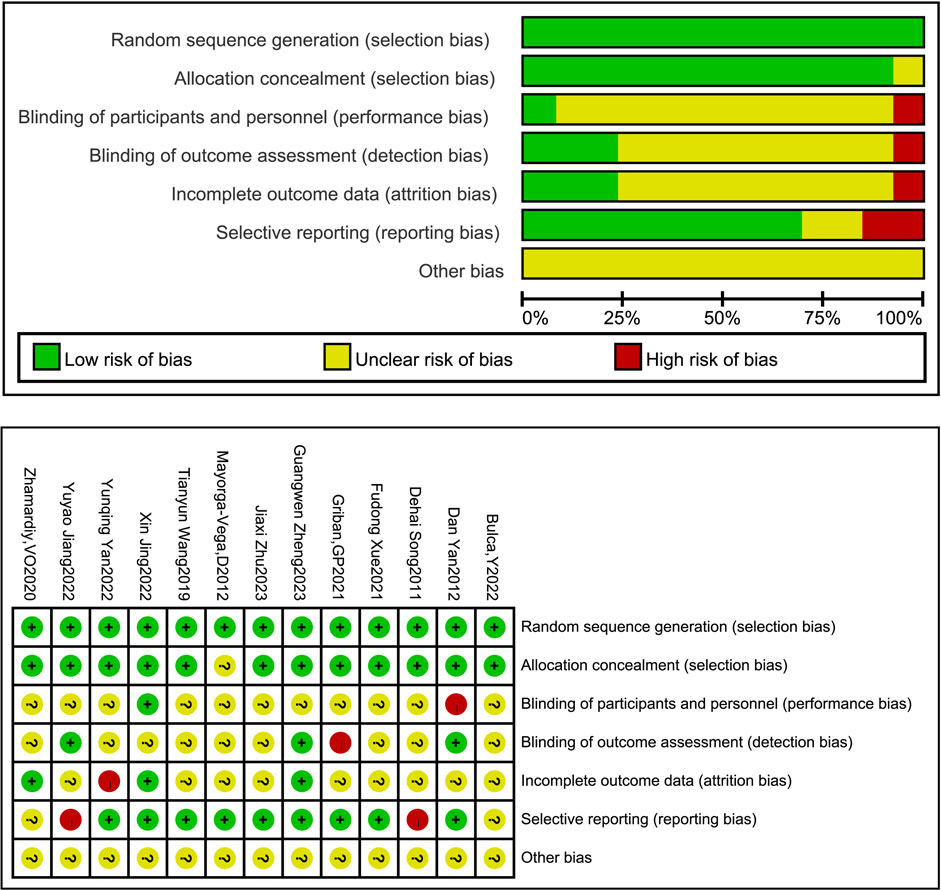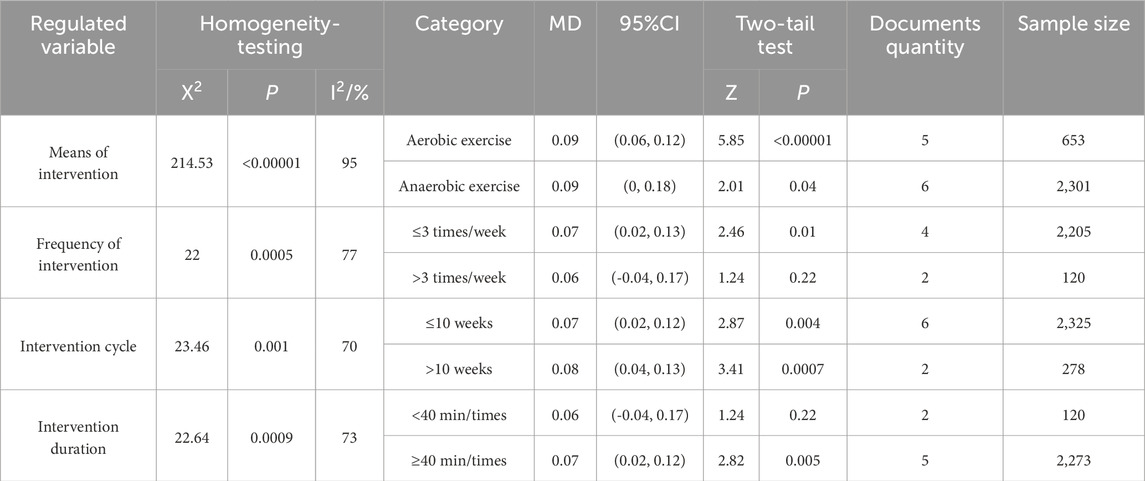- 1Graduate School of Education, Shandong Sport University, Jinan, China
- 2Qufu Normal University, Qufu, China
Background: By using meta-analysis to evaluate the effects of exercise on adolescent body mass index (BMI), standing long jump, sit ups, lung capacity, sitting forward bending, 50 m running, and 800 m running, a large amount of literature will be reviewed to reveal the key role of exercise in the healthy development of adolescents. This study aims to promote the development of adolescent physical health and solve the common problem of declining physical fitness, comprehensively improve the physical fitness of adolescents, and provide decision-making support for policymakers. The research results will provide methodological references for precise and effective intervention practices, further improve adolescent physical fitness, and lay a solid physiological foundation for their comprehensive development.
Methods: A literature search was conducted on China National Knowledge Infrastructure (CNKI) and PubMed, collecting randomized controlled trials (RCTs) that investigated the effects of physical activity on adolescent physical fitness according to predefined criteria. The quality of these studies was assessed, and their outcome data were analyzed using RevMan 5.4 software. The analysis encompassed 13 articles with a total of 4,633 participants, examining measures such as mean difference (MD) and heterogeneity, followed by subgroup analyses.
Results: The meta-analysis revealed that physical activity had a moderate to high effect on adolescent performance in sit-ups (MD = 4.91, 95% CI = 3.41–6.41), vital capacity (MD = 120.66, 95% CI = 48.67–194.46), sit-and-reach test (MD = 0.82, 95% CI = 0.09–1.56), 50-meter dash (MD = −1.05, 95% CI = −1.48 to −0.62), and 800-meter run (MD = −18.48, 95% CI = −24.98 to −11.97). Conversely, its influence on BMI (MD = −0.31, 95% CI = −1.87 to 1.24) and standing long jump (MD = 0.1, 95% CI = 0.05–0.15) was relatively low.
Conclusion: Engaging in physical activities significantly improves adolescent physical fitness. The most effective regimen involves a combination of aerobic and anaerobic exercises, with each session lasting 30 min, performed three times per week for at least 2 months. The extent of improvement in various fitness indicators, reflecting different aspects of physical fitness, is influenced by factors such as the nature of the physical activity, intervention duration, exercise frequency, and age.
Systematic Review Registration: PROSPERO, identifier CRD42024568197
1 Introduction
Adolescence is one of the most rapidly transformative stages of human development and growth. During this period, a constellation of determinants influencing health manifest in distinctive ways and exert unique impacts on the body (World Health Organization, 2017). Students actively participating in sports can not only promote physical growth and development, but also improve the functional level of various organs and systems (LI, 2024). The latest global data show that the majority (81%) of boys and girls aged 11 to 17 engage in moderate to vigorous physical activity for less than 1 hour per day (World Health Organization, 2022). The total amount of physical activity and moderate to high-intensity physical exercise time among Chinese adolescents are relatively low, and the physical activity level of adolescents at different age groups is affected by academic pressure (Li et al., 2024). World Health Organization data indicate that globally, 81% of children and adolescents do not meet the recommended physical activity standards set by the World Health Organization, with approximately 3.2 million individuals dying from chronic diseases due to lack of physical exercise (Yang and Li, 2022). Exercise promotes health and prevents a range of diseases (Watanabe et al., 2021). Based on this, combined with the current analysis of the physical fitness status of adolescents, they need more time to engage in sports activities (Shao, 2022).
At present, adolescents commonly face substantial academic pressure, making it difficult for students to engage in adequate physical activities to strengthen their physique, a situation that is continuously worsening (Guo, 2024). The results of the National Student Physical Fitness Standards tests over the past decade in China demonstrate a declining trend in adolescent physical fitness (Wang J., 2023). Additionally, issues such as a high prevalence of vision impairment and myopia among students, an increasing rate of overweight and obesity, a decline in grip strength levels, and a drop in physical fitness among college students have also been identified (Hepartment of Physical Health and Arts Education Ministry of Education, 2021). From this, it can be seen that the trend of declining physical fitness among Chinese adolescents is increasingly related to various social factors, such as dietary habits, academic pressure, lack of exercise, etc., (Du, 2023). This downward trend not only increases the risk of chronic diseases such as cardiovascular disease, obesity, and diabetes among adolescents but also affects multiple aspects of their lives, including mental health, learning abilities, and social skills. Good physical health can mitigate the genetic predisposition to obesity in children and adolescents (Todendi et al., 2021). There is a significant positive correlation between students’ fitness behavior and physical health, and there is a certain correlation between a healthy lifestyle and physical health indicators (Wang X., 2023). Regular physical activity, including through participation in sports, helps prevent and manage non-communicable diseases such as heart disease, stroke, diabetes, as well as breast and colorectal cancer. It also aids in preventing hypertension, overweight, and obesity, while enhancing mental health and overall well-being (World Health Organization, 2023). In addition, sports activities have other benefits, such as high-intensity interval training (HIIT), which has been proved to be effective in controlling obesity and diabetes (Filipe et al., 2024); Participating in sports activities can make people show a more positive and healthy psychological and emotional state, and exercise can actively and effectively prevent and improve mental health (Wang J. et al., 2024); Physical exercise can directly or indirectly affect the occurrence of vascular aging (Wang C. et al., 2024); Sports activities can also have a positive impact on different stages of tumor diseases, potentially improving overall survival and quality of life, reducing treatment-related toxicity, and improving response to immunotherapy (Ana et al., 2024). The decline in adolescent physical fitness runs counter to the strategic needs of Healthy China (Wang et al., 2017). As is well known, the policy of promoting youth sports and health is an important guarantee for improving the physical health of young people, achieving national strategic goals such as a healthy China and a sports powerhouse (Zhu et al., 2024). Therefore, China places great emphasis on the development of adolescents’ physical fitness. The “Opinions on Building a Higher-level Public Service System for National Fitness” emphasizes fostering lifelong exercisers and ensuring that every adolescent proficiently masters at least one or more sports skills, thereby cultivating a population engaged in various sports disciplines (Xu et al., 2023).
From an article by Stojanović et al. (2023), we find that the TGfU (Teaching Games for Understanding) volleyball intervention has a notably significant effect on enhancing students’ physical fitness. However, Zhen Li’s article posits that small-sided football matches have a positive impact on students’ physical health (Li et al., 2023). Currently, there exists a multitude of perspectives on methods to enhance adolescent physical fitness, with different exercise modalities exerting direct and profound influences on their physical qualities. Existing research fails to definitively identify the most efficacious mode of exercise. To address the issue of improving adolescent physical fitness, this paper integrates a larger dataset, compiling the test results of over four thousand individuals, and conducts a more thorough analysis of the sample. The aim is to discern, through comparative analysis, which type of exercise is most effective in boosting adolescent physical fitness, as well as how to effectively combine various exercise approaches to promote their healthy growth and development.
2 Research methodology
2.1 Literature retrieval strategy
Two researchers selected CNKI, PubMed, and Web of Science databases for literature search. The search time was to build the database until December 2023, and the last search date was 23 December2023. The relevant information was found through the included references, and the unpublished literature was not searched. See Table 1 for the search keywords. Each group of search topic words is connected with “OR”, “AND”, and Boolean operation. In addition, the references of the included literature were traced back by a manual search to ensure the comprehensiveness of the included literature.
2.2 Inclusion and exclusion criteria
Literature type: The experimental design was a randomized controlled trial (RCT), regardless of whether it was blind or not. Study inclusion criteria: 1) Study subjects: Chinese adolescents were selected as the study subjects, and the study subjects were required to be healthy and disease-free. 2) Intervention measures: Exercise intervention was the only intervention measure in the experimental group, with no restrictions on exercise methods, and the control group received routine physical education courses in the school. 3) Outcome indicators: All or part of the indicators (standing long jump, sit ups, lung capacity, sitting forward bending, BMI, 50 m run, 800 m run) tested by the National Physical Fitness Monitoring Standards were used as the outcome indicators. 4) Study design: This study was published in both Chinese and English. A randomized controlled trial was conducted, and there was no significant difference between the experimental group and the control group. Exclusion criteria: 1) studies unrelated to the meta-analysis topic. 2) incomplete outcome indicator data, insufficient data to calculate the mean difference (MD) score after intervention. 3) duplicate or overlapping articles; 4) Review, editorial, animal experiments, or thesis.
2.3 Literature screening and data information extraction
Firstly, the collected literature will be uniformly imported into the literature management software “NoteExpress” and screened: first, duplicate literature in the database will be excluded, and then two researchers will further screen the entire text according to the inclusion and exclusion criteria. Two researchers will compare the included literature, and if the results are different, a third party will decide whether to include it. Independent extraction of literature that meets the criteria will be carried out, including: literature title, first author, publication time, subject age, sample size, sports activity content, exercise frequency, exercise cycle, intervention duration, and outcome indicators.
2.4 Risk assessment of bias included in literature
The bias risk assessment included in the literature was conducted using Cochrane Collaboration’s RCT bias assessment tool (Higgins et al., 2011). Evaluate: 1) the generation of random sequences; 2) Allocation hidden; 3) Blind method between implementers and participants; 4) Blind method for outcome evaluation; 5) The completeness of the result data; 6) Selective reporting; 7) Other sources of bias. The risk of bias will be independently evaluated by two researchers. If there is any disagreement, it will be resolved through negotiation or discussion with the third researcher. Each indicator will be judged based on low bias risk, bias uncertainty, and high bias risk. Based on the judgment results, the quality of the included literature will be divided into three levels: 1) If four or more items are met with low risk, it will be rated as A level; 2) Satisfying 2 or 3 low risk items, rated as B level; 3) Satisfying 1 or no low risk item, rated as C-level.
2.5 Statistical methods
Revman 5.4 was used to statistically analyze the outcome indicators of the included literature. Firstly, heterogeneity testing was performed on the literature, using the Homogeneity test (with a criterion of a = 0.1), i.e., the X2 test. If P < a, it indicates heterogeneity between the studies; On the contrary, the studies are homogeneous. I2 is used to quantitatively evaluate the heterogeneity between studies, and I2 statistics are used to test the level of heterogeneity between studies. According to the Cochrane Handbook evaluation criteria, when I2 = 0, it is considered that there is no heterogeneity between studies; When I2 < 50%, it is considered that there is low heterogeneity between the studies, which is acceptable. A fixed effects model is used for analysis. When I2 > 50%, there is significant heterogeneity between the studies, and a random effects model is used for analysis. If there is high heterogeneity between the studies, subgroup analysis is conducted based on the sources of heterogeneity generated. Funnel plots and Egger tests are used to analyze the impact of publication bias. The test units of the results indicators included in the literature are consistent, so the mean difference is used as the effect size, calculated with a 95% confidence interval, and P < 0.05 is considered significant for the difference.
3 Results
3.1 Literature search results
As shown in Figure 1, according to the formulated search strategy, a total of 5,578 potentially relevant articles were retrieved, out of which 50 were published in international journals. Upon applying the established inclusion and exclusion criteria, 13 articles were ultimately selected for inclusion in the analysis, comprising 9 domestically published studies and 4 studies from overseas sources.
3.2 Basic characteristics of inclusion in literature
This study included a total of 13 articles, with a total sample size of 4,633 people (approximately 48% of males). All participants were adolescents, and both the experimental and control groups reported sample sizes, with 2,008 people in the experimental group and 2,625 people in the control group. Intervention content for the experimental group: 9 articles used aerobic exercise, 4 articles used anaerobic exercise, 7 articles used exercise frequency ≤3 days/week, 1 article had exercise frequency > 3 days/week, 5 articles did not specify exercise frequency, 5 articles had exercise cycle ≤10 weeks, 5 articles had exercise cycle > 10 weeks, 3 articles did not specify exercise cycle, and 5 articles did not specify exercise cycle. Time < 40 min/time, exercise time ≥40 min/time in 4 articles, exercise time not specified in 3 articles, and intervention measures in the control group mostly focused on routine physical activities. The detailed characteristics of the included literature are shown in Table 2.
3.3 Risk bias assessment for inclusion in literature
The two authors used the Cochrane bias risk assessment tool to evaluate the quality of the aforementioned literature. If there were differences, they were handed over to the third author for evaluation, and the final evaluation result of the literature quality was obtained. According to the evaluation criteria of literature quality, as shown in Figure 2, there were 3 low-risk literature that met 4 or more items, and 10 low-risk literature that met 2-3 items. The evaluation results were 3 A-level and 10 B-level literature quality.
3.4 Meta analysis results
3.4.1 The influence of sports activities intervention on the performance of teenagers in standing long jump
A total of 12 studies included standing long jump as an indicator, with 1,379 participants in the experimental group and 1,975 participants in the control group. Heterogeneity testing showed that there was significant heterogeneity among the 12 studies. I2 = 95% > 50%, P < 0.00001, so a random effects model was used to merge the results. After merging, the effective stress MD = 0.1, 95% CI = 0.05∼0.15, P < 0.01 (See Figure 3).
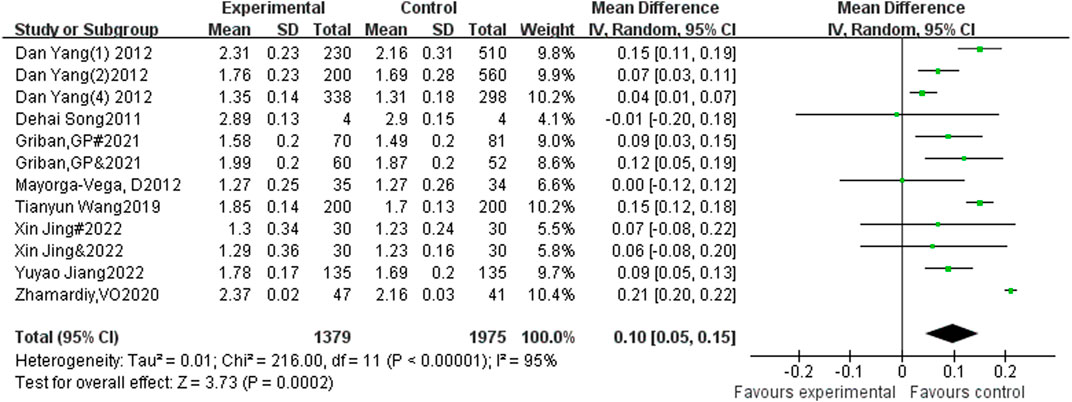
Figure 3. Forest plot of the effect of physical activity intervention on adolescent standing long jump performance.
3.4.2 The impact of sports intervention on sit up performance among adolescents
A total of 9 studies included sit ups as an indicator, with 644 participants in the experimental group and 637 participants in the control group. Heterogeneity testing showed significant heterogeneity among the 9 studies. I2 = 97% > 50%, P < 0.00001, so a random effects model was used to merge the results. After merging, the effective response MD = 4.91, 95% CI = 3.41∼6.41, P < 0.00001 (See Figure 4).

Figure 4. Forest plot of the effect of physical activity intervention on adolescent sit-up performance.
3.4.3 The impact of sports intervention on adolescent lung capacity performance
A total of 5 studies included sitting forward flexion as an indicator, with 1,110 participants in the experimental group and 1,094 participants in the control group. Heterogeneity testing showed that there was significant heterogeneity among the 5 studies. I2 = 64% > 50%, P = 0.007, so a random effects model was used to merge the results. After merging, the effective stress MD = 120.66, 95% CI = 48.67∼194.46, P = 0.001 (See Figure 5).

Figure 5. Forest plot of the effect of physical activity intervention on adolescent pulmonary performance.
3.4.4 The effect of sports activities intervention on sitting forward bending performance of adolescents
A total of 5 studies included sitting forward flexion as an indicator, with 625 participants in the experimental group and 770 participants in the control group. Heterogeneity testing showed that there was small heterogeneity among the 5 studies. I2 = 42% < 50%, P = 0.16, so a fixed effects model was used to merge the results. After merging, the effective stress MD = 0.82, 95% CI = 0.09–1.56, P = 0.03 (See Figure 6).

Figure 6. Forest plot of the effect of physical activity intervention on adolescent Sit forward performance.
3.4.5 The impact of sports intervention on adolescent BMI scores
There were 4 studies that included BMI as an indicator, with 310 participants in the experimental group and 310 participants in the control group. Heterogeneity testing showed significant heterogeneity among the 4 studies. I2 = 97% < 50%, P < 0.00001, so a random effects model was used to merge the results. After merging, the effective stress MD = −0.31, 95% CI = −1.87∼1.24, P = 0.69 (See Figure 7).

Figure 7. Forest plot of the effect of physical activity intervention on adolescent BMI performance.
3.4.6 The influence of sports activities intervention on the performance of teenagers in 50 m running
Three studies included 50 m running as an indicator, with 385 participants in the experimental group and 385 participants in the control group. Heterogeneity testing showed significant heterogeneity among the three studies. I2 = 95% < 50%, P < 0.00001, so a random effects model was used to merge the results. After merging, the effective stress MD = −1.05, 95% CI = −1.48∼−0.62, P < 0.00001 (See Figure 8).

Figure 8. Forest plot of the effect of physical activity intervention on adolescent Run 50 m performance.
3.4.7 The influence of sports activities intervention on the performance of teenagers in 800 m running
A total of 4 studies included 800 m running as an indicator, with 398 participants in the experimental group and 398 participants in the control group. Heterogeneity testing showed that there was significant heterogeneity among the 4 studies. I2 = 70% < 50%, P = 0.02, so a random effects model was used to merge the results. After merging, the effective stress MD = −18.48, 95% CI = −24.98∼−11.97, P < 0.00001 (See Figure 9).

Figure 9. Forest plot of the effect of physical activity intervention on adolescent Run 800 m performance.
3.5 Sensitivity analysis and publication bias of the impact of sports intervention on the standing long jump performance of adolescents
In sensitivity analysis, the combined results of the meta-analysis using the random effects model are consistent with the combined results of the fixed effects model or the main results of the study with the lowest literature quality score removed, indicating that the combined effects of exercise intervention on cognitive function (MD) are stable. To investigate hair bias, funnel plots are usually performed on meta-analyses of more than 10 studies and analyzed. It can be seen that all studies have a good symmetrical distribution; Then, Egger test (Table 3) was performed, with P = 0.024 < 0.05, indicating no significant publication bias.
3.6 Subgroup analysis of the impact of sports intervention on the standing long jump performance of adolescents
3.6.1 The influence of different sports methods on the performance of teenagers in standing long jump
This group included a total of 11 studies with 2,954 participants (see Table 3). The exercise methods were divided into two forms: aerobic exercise and anaerobic exercise for subgroup analysis (Figure 10A). The difference in effect size between the two groups was close to high heterogeneity (I2 = 95%), indicating that the intervention content had a significant regulatory effect on the intervention effect. Among them, heterogeneity testing in the aerobic exercise group showed X2 = 0.84, I2 = 0%, P = 0.93, combined effect size MD = 0.06, 95% CI: 0.06–0.12, P < 0.00001, no statistically significant difference; Heterogeneity test of anaerobic exercise group shows X2 = 189.83, I2 = 97%, P < 0.00001, combined effect size MD = 0.09, 95% CI: 0∼0.18, P = 0.04, the difference is statistically significant. It can be seen that aerobic exercise has the most significant effect size.
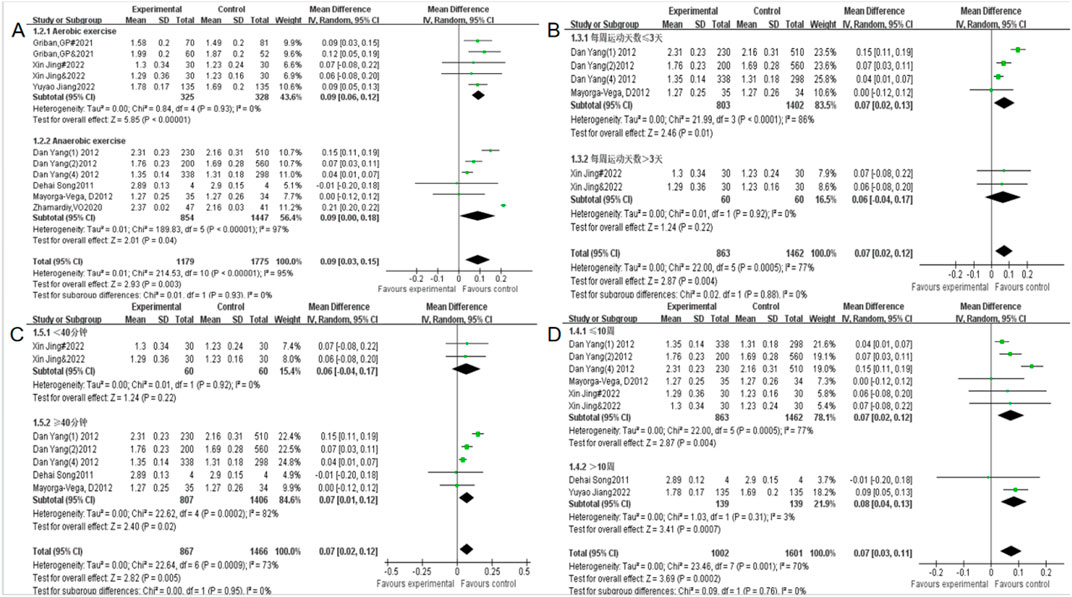
Figure 10. Forest plot of the effect of a physical activity intervention on adolescent standing long jump performance: (A) Exercise form (B) Exercise frequency (C) Exercise time (D) Exercise duration.
3.6.2 The influence of exercise frequency on the performance of teenagers in standing long jump
This group included a total of 6 studies and 2,325 subjects (see Table 3). The exercise frequency was divided into two groups: exercise days ≤3 days per week (including 3 days) and exercise days >3 days per week. The two groups had high heterogeneity in effect size (I2 = 77%), indicating that exercise frequency has a significant regulatory effect on intervention effectiveness (Figure 10B). The heterogeneity test of exercise days ≤3 days per week showed: X2 = 21.99, I2 = 86%, P < 0.0001, combined effect size MD = 0.07, 95% CI: 0.02–0.13, P = 0.01, the difference is statistically significant. Heterogeneity test for exercise >3 days per week shows: X2 = 0.01, I2 = 0%, P = 0.92, combined effect size MD = 0.06, 95% CI: −0.04∼0.17, P = 0.22, no statistically significant difference.
3.6.3 The influence of exercise cycle on the performance of teenagers in standing long jump
This group included a total of 8 studies with 2,603 participants (see Table 3), and divided the exercise cycle into ≤10 weeks (including 10 weeks) and >10 weeks. The difference in effect size between the two groups was close to high heterogeneity (I2 = 70%), indicating that the exercise cycle has a significant moderating effect on the intervention effect (Figure 10C). The heterogeneity test of adolescent standing long jump performance for exercise duration ≤10 weeks showed: X2 = 22, I2 = 77%, P = 0.0005, combined effect size MD = 0.07, 95% CI: 0.02–0.12, P = 0.004, the difference is statistically significant; Heterogeneity test of standing long jump performance in adolescents with exercise duration greater than 10 weeks shows X2 = 1.03, I2 = 3%, P = 0.31, combined effect size MD = 0.08, 95% CI: 0.04–0.13, P = 0.0007, the difference is statistically significant, and the effect size is most significant for exercise cycles >10 weeks.
3.6.4 The influence of exercise time on the performance of teenagers in standing long jump
This group included a total of 7 studies with 2,393 participants (see Table 4). The exercise time was divided into single exercise time <40 min and single exercise time ≥40 min (including 40 min). The two groups showed high heterogeneity in effect size differences (I2 = 73%), indicating that exercise time has a significant regulatory effect on intervention effects (Figure 10D). Heterogeneity tests for single exercise time <40 min showed: X2 = 0.01, I2 = 0%, P = 0.92, combined effect size MD = 0.06, 95% CI -0.04–0.17, P = 0.22, no statistically significant difference, heterogeneity test for single exercise ≥40 min showed: X2 = 22.62, I2 = 82%, P = 0.0002, combined effect size MD = 0.07, 95% CI: 001∼0.12, P = 0.02, the difference is statistically significant.
3.7 Subgroup analysis of the impact of sports intervention on sit up performance among adolescents
3.7.1 The influence of different exercise methods on the performance of sit ups in adolescents
This group included a total of 9 studies, with 1,281 participants. The exercise methods were divided into two forms: aerobic exercise and anaerobic exercise for subgroup analysis (Figure 11). The difference in effect size between the two groups was close to high heterogeneity (I2 = 97%), indicating that the intervention content had a significant regulatory effect on the intervention effect. Among them, the heterogeneity test of the aerobic exercise group showed X2 = 233, I2 = 97%, P < 0.00001, combined effect size MD = 4.54, 95% CI: 2.53–6.56, P < 0.00001, the difference is statistically significant; Heterogeneity test of anaerobic exercise group shows X2 = 3.41, I2 = 71%, P = 0.06, combined effect size MD = 5.88, 95% CI: 3.67–8.1, P < 0.00001, the difference is statistically significant. It can be seen that aerobic exercise has the most significant effect size.
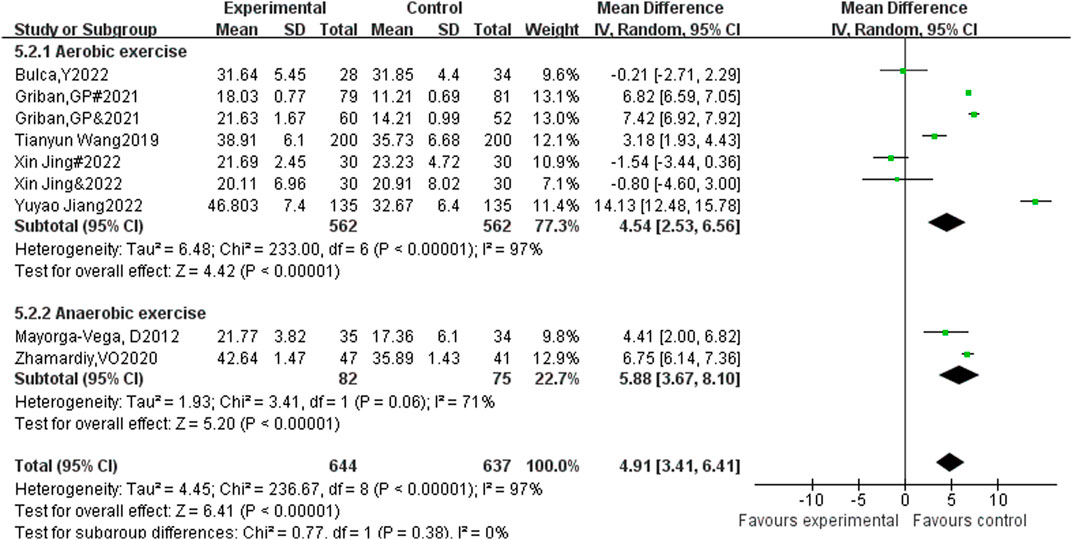
Figure 11. Forest plot of the effect of a physical activity intervention on adolescent sit-up performance.
4 Discuss
Numerous studies have already demonstrated the efficacy of physical exercise in enhancing the physical fitness of adolescents; however, the precise magnitude of this effect remains unclear. The present meta-analysis of 13 included articles reveals that, compared to control groups, physical activity interventions generally exert a positive influence on the performance of adolescents in standing long jump, sit-ups, vital capacity, sit-and-reach test, body mass index (BMI), 50-meter dash, and 800-meter run. Nonetheless, improvements in certain performance metrics were found to be statistically nonsignificant.
Standing long jump is an important sports event for cultivating students’ physical fitness (Yang, 2021), It plays an important role in improving students’ speed, strength, and coordination abilities (Shang, 2023). The meta-analysis results of this study showed that among the 12 studies included, including standing long jump, one study was statistically insignificant, with a combined MD value of 0.1. In the study, the sports cycle is mostly around 10 weeks, which may be due to considerations for the adolescent semester. Generally, a semester for adolescent students lasts for 16 weeks. Excluding pre-test, post test, and other preparatory activities, a 10 weeks intervention exercise cycle is more appropriate. From the perspective of intervention period, the effect of exercise intervention for more than 10 weeks was greater than that for 10 weeks and below; From the perspective of intervention time, exercise intervention with a duration of 40 min or more has a better effect than exercise intervention with a duration of less than 40 min; From the perspective of intervention frequency, the effect of a frequency of exercise days ≤3 days per week is better than a frequency of exercise days above 3 days. It can be seen that training with longer cycles and longer single training times will have better effects. However, from the perspective of exercise frequency, we found that it is not necessarily better to train more frequently per week. Because longer rest time can enhance people’s muscle strength (Brad et al., 2024), Post-exercise recovery is far more than just “rest”; it is a vital process of recharging the body, preparing it for the next round of exertion (Cao, 2023). In summary, physical activity interventions with longer durations (over 10 weeks) and longer training times (at least 40 min per session) have better effects. In addition, exercising no more than three times a week is more effective than frequent high-intensity training. These conclusions remind us that a scientifically reasonable training plan should consider the importance of training continuity and recovery period, and avoid the negative effects of overtraining.
Sitting forward bending is an indicator of flexibility reflected in the national student physical health standards (Sun and Sun, 2022), Pulmonary capacity is one of the indicators in lung function measurement. The meta-analysis results of this study showed that all 5 studies including sitting forward flexion had statistical significance, and the combined intervention effect was high. There were a total of 8 studies including pulmonary capacity, all of which had statistical significance, and the combined intervention effect was high. At the same time, when conducting subgroup analysis based on the sports content studied, the MD values of studies with aerobic exercise as the intervention method were much higher than those with anaerobic exercise. Therefore, it can be seen that performing aerobic exercise alone or combining resistance exercise with aerobic exercise, but not resistance exercise alone, can improve the risk of composite cardiovascular disease (Duck-Chul et al., 2024). And aerobic training is also associated with reduced visceral fat in the abdomen, which may be beneficial for the cardiovascular metabolic health of obese individuals (Jean-Michel et al., 2023). So, when designing sports activities, combining aerobic and anaerobic exercise is the optimal choice. For example, aerobic exercise has shown higher efficacy in improving cardiovascular function; In terms of enhancing abdominal muscle endurance, anaerobic exercise is recommended. This indicates that when designing youth sports activity plans, the characteristics of different types of sports should be taken into account to achieve the goal of comprehensively improving the physical fitness of young people.
The purpose of sit ups is to test abdominal muscle endurance (Wang and Shang, 2022). The meta-analysis results of this study showed that all 9 studies containing sit ups were statistically significant and had high intervention effects after merging. At the same time, when conducting subgroup analysis based on the physical activity content of the study, it was found that the MD value of anaerobic exercise was slightly higher than that of aerobic exercise, because sit ups are anaerobic exercise (Yang et al., 2024). However, we found that Yuyao Jiang’s body function training also had a good effect on improving sit up performance. Therefore, we can combine anaerobic exercise training with body function training to improve sit up performance.
Body mass index (BMI) is an important indicator of human health (Xiang et al., 2024). And the 50 m run and 800 m run correspond to speed (Han, 2022) and endurance (QIao, 2022), respectively. The meta-analysis results of this study showed that all 8 articles included in the 3 outcome indicators had statistical significance, and the combined effect was good.
In addition, we can also explore the optimal exercise combination mode, such as comparing the effects of anaerobic exercise and aerobic exercise. We found that aerobic exercise has a significant effect on improving lung capacity and sitting forward bending, indicating that aerobic exercise can effectively improve the cardiovascular function and flexibility of adolescents; Anaerobic exercise is slightly better than aerobic exercise in improving sit up performance, because sit ups mainly test abdominal muscle endurance and belong to the category of anaerobic exercise. In addition, we found that Yuyao Jiang’s physical function training had a good effect on improving sit up performance, indicating that functional training can be added to anaerobic exercise training.
Through discussion, we found that by participating in sports activities, teenagers can improve their physical function and develop healthy lifestyle habits. This is of great significance for preventing chronic diseases such as obesity and cardiovascular disease. At the same time, the results of this study can provide important reference for policymakers when planning school physical education curriculum and public health strategies. By drawing on this discussion, we can better formulate sports policies that meet the growth needs of young people and promote their healthy development. In addition, schools and families can encourage young people to actively participate in sports activities based on research recommendations, and focus on the quality of activities rather than quantity. Through appropriate exercise interventions, help children improve their physical fitness while enjoying the fun of sports, laying a solid foundation for the future.
5 Conclusion
Based on the meta-analysis results of the seven physical fitness outcome indicators mentioned above, it can be concluded that sports content, cycle, single time, and frequency are important influencing factors for the intervention effect of adolescent sports activities.
Regular physical exercise has shown moderate to high effects in improving adolescent sit ups, lung capacity, flexibility (sitting forward), short distance speed (50 m run), and long-distance endurance (800 m run). However, for BMI index and standing long jump, the influence of sports activities is relatively low.
Further research has found that the most effective exercise intervention plan should be a combination of aerobic and anaerobic exercise, and it is recommended to exercise for no less than 30 min each time, at least three times a week, and for a duration of at least 2 months. This training frequency and duration can be accepted by most teenagers, and can leave enough time for recovery after exercise to achieve the best training results.
In addition to the above factors, the sensitive period of adolescent physical fitness development is also an important factor affecting the effectiveness of intervention. For example, the speed sensitive period is between the ages of 14–16; The period of strength sensitivity is between 13 and 17 years old; The endurance sensitive period is from 16 to 18 years old. So when conducting research grouping. It is essential to fully consider the age characteristics and developmental stages of adolescents.
In summary, this study confirms the importance of physical activity in improving adolescent health and provides strong evidence to support the development of more scientific and reasonable exercise intervention plans. For sports educators, sports coaches, parents, and policymakers, these findings will help guide the planning and implementation of youth sports activities, thereby promoting the healthy growth of young people and contributing to the construction of a “Healthy China”.
Data availability statement
The original contributions presented in the study are included in the article/supplementary material, further inquiries can be directed to the corresponding authors.
Author contributions
JS: Writing–review and editing, Investigation, Writing–original draft. ZS: Writing–review and editing, Supervision. JK: Supervision, Writing–review and editing. XT: Supervision, Writing–review and editing. LW: Supervision, Writing–review and editing. QW: Supervision, Writing–review and editing. JX: Supervision, Writing–review and editing.
Funding
The author(s) declare that financial support was received for the research, authorship, and/or publication of this article. This work was supported by grants from the central government guides local science and technology development funds (YDZX2022091), the Taishan Scholars Program of Shandong Province (tsqn201909148).
Conflict of interest
The authors declare that the research was conducted in the absence of any commercial or financial relationships that could be construed as a potential conflict of interest.
Publisher’s note
All claims expressed in this article are solely those of the authors and do not necessarily represent those of their affiliated organizations, or those of the publisher, the editors and the reviewers. Any product that may be evaluated in this article, or claim that may be made by its manufacturer, is not guaranteed or endorsed by the publisher.
References
Ana I., Martin Q. M. A., Hennessy Q., Ana C. G. (2024). Charting cancer’s course: revealing the role of diet, exercise, and the microbiome in cancer evolution and immunotherapy response. J. Clin. Transl. Oncol., 1–13. doi:10.1007/S12094-024-03595-1
Brad J. S., Zachary K. P., Franklin M. B., Garrett M. H., John S., Josh L. N. (2024). Longer interset rest periods enhance muscle strength and hypertrophy in resistance-trained men. J. Strength Cond. Res. 30 (7), 1805–1812. doi:10.1519/JSC.0000000000001272
Bulca Y., Bilgin E., Altay F., Demirhan G. (2022). Effects of a short video physical activity program on physical fitness among physical education students. Percept. Mot. Ski. 129, 932–945. doi:10.1177/00315125221088069
Cao X. (2023). The rest of the technology content after exercise recovery can be more effective. Jian Mei (10), 28–31.
Du P. (2023). The relationship and countermeasures of adolescent physical fitness decline in track and field monitoring. Bull. Sports Sci. Technol. 2023 (20), 142–144. doi:10.3969/j.issn.1006-8902.2023.20.049
Duck-Chul L., Angeliqu G. B., Lorraine M. L., Marian L. K., Yehua L. (2024). Aerobic, resistance, or combined exercise training and cardiovascular risk profile in overweight or obese adults: the CardioRACE trial. Eur. Heart J. 45 (13), 1127–1142. doi:10.1093/eurheartj/ehad827
Filipe M. R., Bernardo P., Maycon A., Victoria A., Thiago R., Hugo C., et al. (2024). Discontinuation of HIIT restores diabesity while retraining increases gut microbiota diversity. J. iScience 27 (8), 110365. doi:10.1016/J.ISCI.2024.110365
Griban G. P., Kuznіetsova O. T., Lyakhova N. A., Prystynskyi V. M., Oleniev D. G., Otravenko O. V., et al. (2021). Dynamics of students’ fitness level while differentiating physical education classes in accordance with their health and nosology of diseases. Wiad Lek 74 (3 cz 2), 641–646. doi:10.36740/WLek202103214
Guo M. (2024). Methods to improve the physical health level of high school students. Jian Mei (01), 133–135.
Han X. (2022). Talk about junior high school students 50 meters running training. Athletics (12), 48–49.
Hepartment of Physical Health and Arts Education Ministry of Education (2021). Release report of the eighth national survey on student physical fitness and health. China J. Sch. Health. 42 (09), 1281–1282. doi:10.16835/j.cnki.1000-9817.2021.09.001
Higgins J. P., Altman D. G., Gøtzsche P. C., Jüni P., Moher D., Oxman A. D., et al. (2011). The Cochrane Collaboration's tool for assessing risk of bias in randomised trials. BMJ 343, d5928. doi:10.1136/bmj.d5928
Jean-Michel O., Cécile C., Alice B. (2023). Physical activity and exercise for weight loss and maintenance in people living with obesity. Rev. Endocr. Metab. Disord. 24 (5), 937–949. doi:10.1007/s11154-023-09805-5
Jiang Y., Liu M., Zhang F., Huang Y., Lu W., Wang W. (2022). Exploration and application of physical function training in college PE course —— take zibo normal college as an example. Sports Vis. (13), 118–120.
Jing X. (2022). In-depth analysis of the influence mechanism of campus football on adolescent physical health. J. Chifeng Univ. Nat. Sci. Ed. 38 (03), 43–48. doi:10.13398/j.cnki.issn1673-260x.2022.03.009
Li J., Luo Q., Feng L. (2024). Analysis of the characteristics of physical activity behavior and health distribution among Chinese adolescents. Sports Technol. Lit. Bull. 32 (03), 118–121.
Li Z., Krustrup P., Randers M. B., Xu B., Yang W., Huang Z., et al. (2023). “11 for Health” in China - effects on physical fitness in 9-11-year-old schoolchildren. Eur. J. Sport Sci. 23 (12), 2291–2298. doi:10.1080/17461391.2023.2227139
Li C. (2024). A study on the fear of sports among adolescent girls during their physiological period. Contemp. sports Technol. 14 (03), 179–182.
Mayorga-Vega D., Viciana J., Cocca A., de Rueda Villén B. (2012). Effect of a physical fitness program on physical self-concept and physical fitness elements in primary school students. Percept. Mot. Ski. 115 (3), 984–996. doi:10.2466/06.10.25.PMS.115.6.984-996
Qiao M. (2022). Talk about improving the junior high school girls 800 meters running results of the training methods. Athletics (03), 46–48.
Shang R. (2023). Discusses the teaching and training strategies of standing long jump in junior high school. Athletics (12), 46–48.
Shao J. (2022). Research on the importance of healthy fitness training in improving the physical fitness of adolescents. Sci. Technol. Stationery Sport. 2022 (05), 17–19. doi:10.3969/j.issn.1006-8902.2022.05.008
Song D. (2011). Effect of resistance training on the performance of young sprinters —— take stripe practice as an example. Anhui Sports Sci. Technol. 32 (06), 47–49 + 59. doi:10.3969/j.issn.1008-7761.2011.06.014
Stojanović D., Momčilović V., Zadražnik M., Ilić I., Koničanin A., Padulo J., et al. (2023). School-based TGfU volleyball intervention improves physical fitness and body composition in primary school students: a cluster-randomized trial. Healthc. (Basel) 11 (11), 1600. doi:10.3390/healthcare11111600
Sun T., Sun X. (2022). The influence of National Students' Physical education in colleges and universities. J. Shanxi Univ. Finance Econ. 44 (S1), 140–142.
Todendi P. F., Brand C., Silveira J. F. C., Gaya A. R., Agostinis-Sobrinho C., Fiegenbaum M., et al. (2021). Physical fitness attenuates the genetic predisposition to obesity in children and adolescents. Scand. J. Med. Sci. Sports 31 (4), 894–902. doi:10.1111/sms.13899
Wang C., Xuan J., Chen J., Jia X., Su H., Guo Z. (2024). Risk prediction model of psychological behavior and physical exercise on vascular aging. Chin. J. Behav. Med. Neurosci. 33 (08), 713–719. doi:10.3760/cma.j.cn371468-20231217-00309
Wang J. (2023). “Research on collaborative governance pathways to enhance the physical health of adolescents under the background of sports and education integration,” in The 13th national convention on sport science of China (Tianjin, China).
Wang J., Feng Q., Fan C., Wang C., Wang M. (2024). The current status of mental health among Chinese residents aged 20-79 and its relationship with physical exercise. Chin. J. Behav. Med. Neurosci. 33 (08), 699–705. doi:10.3760/cma.j.cn371468-20240424-00186
Wang P., Shang K. (2022). Review of sit-ups in physical training as well as test methods. Bull. Sports Sci. Technol. (08), 100–102. doi:10.3969/j.issn.1006-8902.2022.08.035
Wang T. (2019). The influence of “Campus Sunshine Health Run” on the physical health level of college students. Bull. Sports Sci. Technol. 17, 209–210.
Wang X. X. (2023). Investigation and analysis of the relationship between college students' fitness behavior and physical health. Contemp. Sports Technol. 13 (35), 177–181.
Wang Z., Liu L., Zhang Y. (2017). Exploration of the era characteristics and governance system of youth sports development in China. Sports Sci. 38 (05), 69–75. doi:10.13598/j.issn1004-4590.2017.05.012
Watanabe L. P., Nicole C. R. (2021). Exercise-induced changes in climbing performance. R. Soc. open Sci. 8 (11), 211275. doi:10.1098/rsos.211275
World Health Organization (2017). Global accelerated action for the health of adolescents (AA-HA!): guidance to support country implementation. Available at: https://www.who.int/publications/i/item/9789241512343 (Accessed January 1, 2017).
World Health Organization (2022). Global status report on physical activity 2022. Available at: https://www.who.int/teams/health-promotion/physical-activity/global-status-report-on-physical-activity-2022 (Accessed October 19, 2022).
World Health Organization (2023). Sport for health conference. Qatar: Doha. Available at: https://www.who.int/publications/i/item/9789240076402 (Accessed September 25, 2023).
Xiang C., Zheng X., Zhuang J., Zang C. (2024). BMI estimation method integrating face image depth and appearance features. Sensors Microsystems 43 (01), 135–138 + 144.
Xu Y., Song J., Xu J. (2023). “The current situation and optimization path of integrating children's physical fitness training into aerobics courses under the background of integration of sports and education,” in The 10th China physical training science conference of China (Guangzhou Guangdong, China).
Xue F. (2021). Study on the effect of “Legar” running on adolescent physique. Sci. Technol. Inf. 19 (24), 196–198. doi:10.16661/j.cnki.1672-3791.2110-5042-7671
Yan Y. (2022). Study on the influence of mass aerobics on the strength and flexibility quality of primary school students. Bull. Sport Sci. Technol. (10)69–71. doi:10.3969/j.issn.1006-8902.2022.10.024
Yang D., Zhang S., Men C., Chen X. (2012). Study on the effect of fitness intervention on different age groups of adolescents in Liaoning. J. Shenyang Phys. Educ. Inst. 31 (05), 89–94. doi:10.3969/j.issn.1004-0560.2012.05.024
Yang J., Li M. (2022). “Design, implementation, and inspiration of foreign mass fitness action plans under the background of healthy China action,” in The 12th national convention on sport science of China2022 (Rizhao, Shandong, China).
Yang M. (2021). Research on the training strategy of standing long jump movement technology and improving performance. Athletics (04), 25–26.
Yang Y., Wu J., Wei S., Li W. (2024). The development and enlightenment of the physical health assessment of Japanese children and adolescents. Chin. J. Sch. Health 45, 157–161.
Zhamardiy V. O., Shkola O. M., Okhrimenko I. M., Strelchenko O. G., Aloshyna A. I., Opanasiuk F. H., et al. (2020). Checking of the methodical system efficiency of fitness technologies application in students' physical education. Wiad. Lek. 73 (2), 332–341. doi:10.36740/wlek202002125
Zheng G., He Y. (2023). Practical research on promoting the development of cardiopulmonary endurance in junior high school students under the background of new physical education examination. Sports Sci. Technol. literature Bull. 31 (02), 144–147. doi:10.19379/j.cnki.issn.1005-0256.2023.02.038
Zhu J. (2023). The influence of basketball training on children's body form and physical health. Bull. Sports Sci. Technol. (08), 120–122. doi:10.3969/j.issn.1006-8902.2023.08.041
Keywords: physical activity, physical health, adolescent, intervention experiment, meta-analysis
Citation: Sun J, Sun Z, Kong J, Tian X, Wang L, Wang Q and Xu J (2024) Regular meta-analysis of the impact of sports activities intervention on some items of the national student physical health standards for adolescents. Front. Physiol. 15:1419441. doi: 10.3389/fphys.2024.1419441
Received: 18 April 2024; Accepted: 14 October 2024;
Published: 24 October 2024.
Edited by:
Giancarlo Condello, University of Parma, ItalyReviewed by:
Edi Setiawan, Surabaya State University, IndonesiaDana Badau, Transilvania University of Brașov, Romania
Copyright © 2024 Sun, Sun, Kong, Tian, Wang, Wang and Xu. This is an open-access article distributed under the terms of the Creative Commons Attribution License (CC BY). The use, distribution or reproduction in other forums is permitted, provided the original author(s) and the copyright owner(s) are credited and that the original publication in this journal is cited, in accordance with accepted academic practice. No use, distribution or reproduction is permitted which does not comply with these terms.
*Correspondence: Qinglu Wang, d3FsX3pjcUAxMjYuY29t; Jun Xu, MjE1NDM3MTM3QHFxLmNvbQ==
 Jikun Sun1
Jikun Sun1 Jianda Kong
Jianda Kong Xuewen Tian
Xuewen Tian Liping Wang
Liping Wang Qinglu Wang
Qinglu Wang